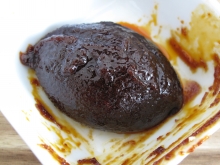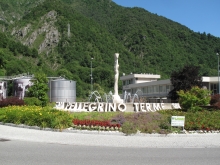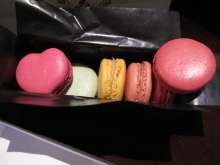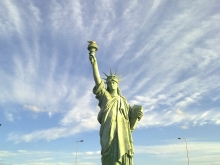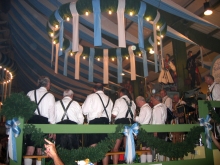
Size: 3 cm
Height: 2.5-2.8 cm
It looks like a sweet mini sandwich, generally composed of 2 pieces of sweet meringue-based confection and 1 layer of ganache with other ingredients such as champagne, chocolate, vanille, exotic fruits and nuts. What is it? Let's go to Luxembourg:
The story began In 1957, Camille Studer, a confectioner from Luxembourg created "Luxemburgerli" by using the french recipe for candies during the time he worked in Zurich and joined the contest. The name "Luxemburgerli" is in Swiss German, means "The little man from Luxembourg". It became a special dessert of the exclusive bakery shop called "Sprüngli", Switzerland. The little men from Luxembourg are nicely packed in a box and suggested to be consumed immediately because the moisture would make the meringue sandwiches softer:
As it is based of french recipe, french Meringue is made with egg white, icing sugar, granulated sugar, almond powder/flour (ground almond), and food colouring. Meringue can be just egg white and sugar:
Sometimes, various colors and flavors are added, especially in french pastry shops:
Many claims to have invented this macaron, but for sure this word is derived from Italian word "Maccarone". History from wikipedia, "Macarons have been produced in the Venetian monasteries since the 8th century A.D." Therefore, some bakery shops came up with different names for it. For example, a bakery shop in Switzerland that made this macaron called " Zugerli" and others. They look about the same style (sometimes, macaron is a bigger size than Luxemburgerli). As the name is copyrighted, therefore only this bakery shop is allowed to call it "Luxemburgerli".
It is time for our little man from Luxembourg or Luxemburg (German) to show us his fatherland. First of all, Luxembourg has a border to Belgium(West and North), Germany (East) and France(South). The official languages are German, French and Luxembourgish. The first impression would be a modern city with viaduct called "Passerelle" via the river Pétrusse valley, or "Pétrussetal", opened in 1861:
After walking around in the city, you will see the Bock fortifications by Christophe-Guillaume Selig (1791-1837):
The Bock Casemates and the Clausen Viaduct (at the background) are located in the historical district of Luxembourg city(North Eastern) The Bock or "Bockfiels" in Luxembourgish is a natural fortification, surrounded with rocky cliffs and the river Alzette. In the history, many castles and fortifications were built on the promontory (a formation of land to massive structure) like this as well. The Bock cliff with cannon holes ( the banisters are built later):
According to the history, around 963, the Count Siegfried looked for a natural site including the bock fortification that belonged to St. Maximin's Abbey in Trier in exchange of his land at Feulen in the Ardennes. He built the Castle of Lucilinburhuc in 963.
From 963 to 1443 Luxembourg was independent as a County until 1354 as a Duchy. Before the Napolean came, the fort survived many attacks from Spanish, French, Burgundian rulers. The bock was rebuilt, reinforced from time to time.
In 1815, it was under the Congress of Vienna and decided to create a new country at this site (around the castle and the bock) called "The Grand Duchy of Luxembourg". Nowadays, The Grand Ducal Palace is the official residence of the Grand Duke of Luxembourg:
It was the city hall and the headquarter of Luxembourg Government until 1817. (Image was taken in the morning of Christmas Eve)
The fortress of Luxembourg was one of the best strategic location in Europe, so called “Gibraltar of the North”. It refers to the fortifications of Gibraltar or the rock of Gibraltar (monolithic limestone promontory) which is located in the British overseas territory. Gibraltar is derived from the Spanish word of "Jabal Ṭāriq" , the Arabic name means "Mountain of Tariq" and Tariq ibn-Ziyad is the general of the main Umayyad force in 711. The previous name of this mountain was known as "Mons Calpe". The side of mountain that is splited is called "Gibraltar", the other side is called "Monte", together is called " The Pillars of Hercules".
There is a myth that Hercules smashed the atlas (mountain) with his super strength power, then Atlantic Ocean is connected to the Mediterranean sea and formed "the Strait of Gibraltar".
Next, Pont du Château, the two-storey bridge connecting the Bock to the old town:
It was an important part of the fortifications, built by the Austrian rulers in 1735 providing the ways of crossing between the cliffs. (the road at the top, a passage, a spiral staircase up through the main arch and a tunnel under the road at the bottom). This site became one of The UNESCO World Heritage Site:
Another bridge is called "The Grand Duchess Charlotte Bridge" or "The Red Bridge", named after her because she did the official groundbreaking in 1963:
The bridge was known to be the suicidal place by jumping off the bridge. (Do not recommend!) However, the upper part of the city when you look up, many modern design buildings are built above this site:
The interior is quite spacious and transparent. The glass walls and windows let the light into the building:
It is like the futuristic world in the historical monuments. In which world would you like to be?
Our next article: Macaron Français












